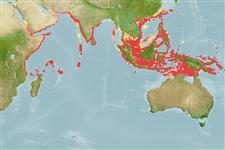Environment: milieu / climate zone / depth range / distribution range
Ecologie
marien rifbewoner; diepte 24 - 90 m (Ref. 11441). Tropical; 27°N - 13°S, 39°E - 158°E (Ref. 5222)
Indo-West Pacific: Gulf of Oman to Kenya, including Laccadive Islands, India, Sri Lanka, and the Andaman Islands. Not reported in the Red Sea and Persian Gulf. Known also from Indonesia, Sarawak of Malaysia, New Guinea, Papua New Guinea, Solomon Islands, and the Philippines.
Lengte bij maturiteit / Grootte / Gewicht / Leeftijd
Maturity: Lm ?, range 41 - ? cm
Max length : 120 cm TL mannelijk / geslacht onbekend; (Ref. 89707); common length : 45.0 cm TL mannelijk / geslacht onbekend; (Ref. 5450); max. gepubliceerd gewicht: 6.4 kg (Ref. 5222)
Dorsale stekels (totaal): 11; Dorsale zachte stralen (totaal): 17-19; Anale stekels 3; Anale zachte stralen: 8. Distinguished by the following characteristics: head, body and fins purplish grey to brownish grey; head with brown to golden brown dots and wavy longitudinal lines of the same colour on the dorsal part of the body (lines faint of absent on large specimens); narrowly blackish margin of spinous dorsal fin; body depth contained 2.7-3.1 times in SL; head length 2.5-2.7 times in SL; convex interorbital area; angular preopercle, notch above angle and enlarged serrae at angle; straight or slightly concave upper edge of operculum; subequal posterior and anterior nostrils or slightly larger posterior nostril; maxilla reaches to vertical at rear edge of eye; ventral edge of maxilla in adults with prominent knob or hook-like process; 2 rows of teeth on midlateral part of lower jaw (Ref. 89707).
Lives on muddy open substrate, seeking refuge in holes in the mud or with solid structures, shipwrecks or debris. A flighty species (Ref; 48635). Also found on banks (Ref. 5222). Feeds on small fishes and crustaceans (stomatopods), shrimps, and pelagic tunicates (Thalia and Pyrosoma sp.) (Ref. 5222). Solitary (Ref 90102).
Levenscyclus en paargedrag
Maturiteit | Voortplanting | Paaien | Eieren | Fecunditeit | Larven
Heemstra, P.C. and J.E. Randall, 1993. FAO Species Catalogue. Vol. 16. Groupers of the world (family Serranidae, subfamily Epinephelinae). An annotated and illustrated catalogue of the grouper, rockcod, hind, coral grouper and lyretail species known to date. Rome: FAO. FAO Fish. Synop. 125(16):382 p. (Ref. 5222)
Status op de Rode Lijst van het IUCN (Ref. 130435)
Gevaar voor de mens
Harmless
Gebruik door de mens
Visserij: van minder commercieel belang
Tools
Speciale rapporten
Download XML
Internetbronnen
Estimates based on models
Preferred temperature (Ref.
123201): 23.9 - 28.6, mean 27.5 °C (based on 499 cells).
Fylogenetische diversiteitsindex (Ref.
82804): PD
50 = 0.5000 [Uniqueness, from 0.5 = low to 2.0 = high].
Bayesian length-weight: a=0.00724 (0.00423 - 0.01239), b=2.93 (2.79 - 3.07), in cm total length, based on LWR estimates for this species & Genus-body shape (Ref.
93245).
Trofisch niveau (Ref.
69278): 3.7 ±0.51 se; based on food items.
Weerstandsvermogen (Ref.
120179): Zeer laag, minimale populatieverdubbelingstijd meer dan 14 jaar (Preliminary K or Fecundity.).
Fishing Vulnerability (Ref.
59153): High to very high vulnerability (72 of 100).
